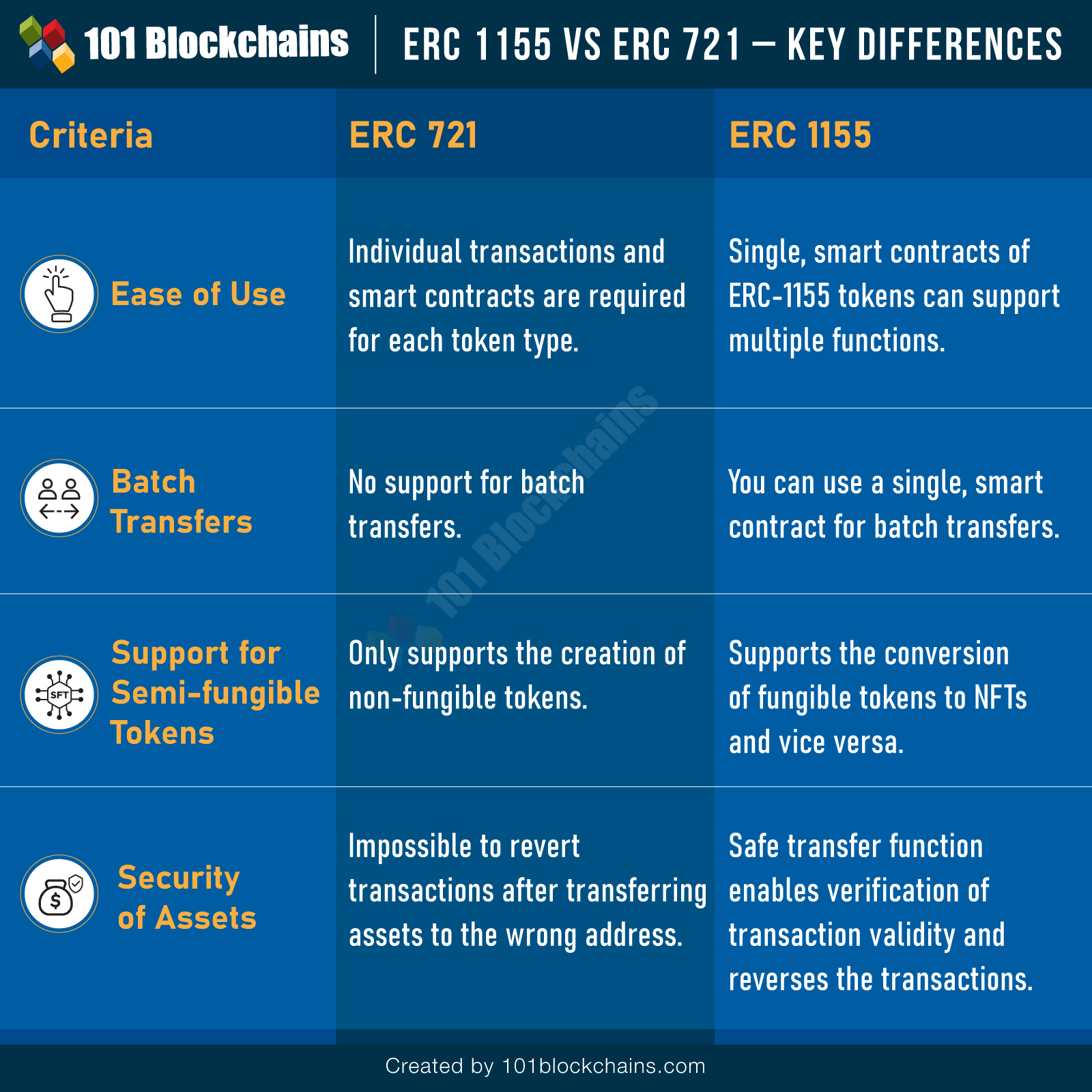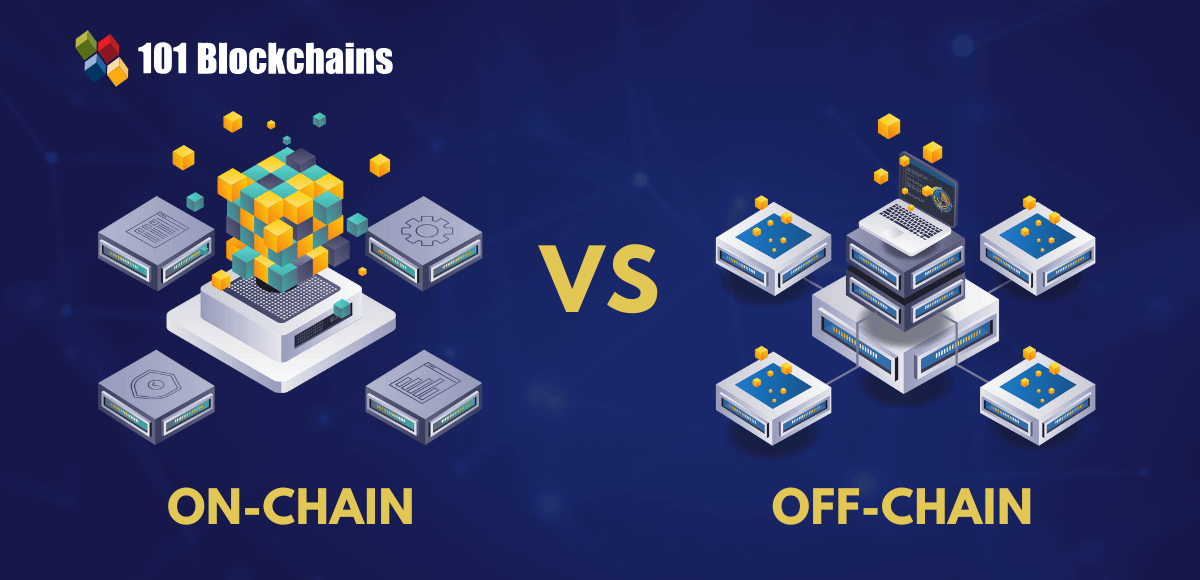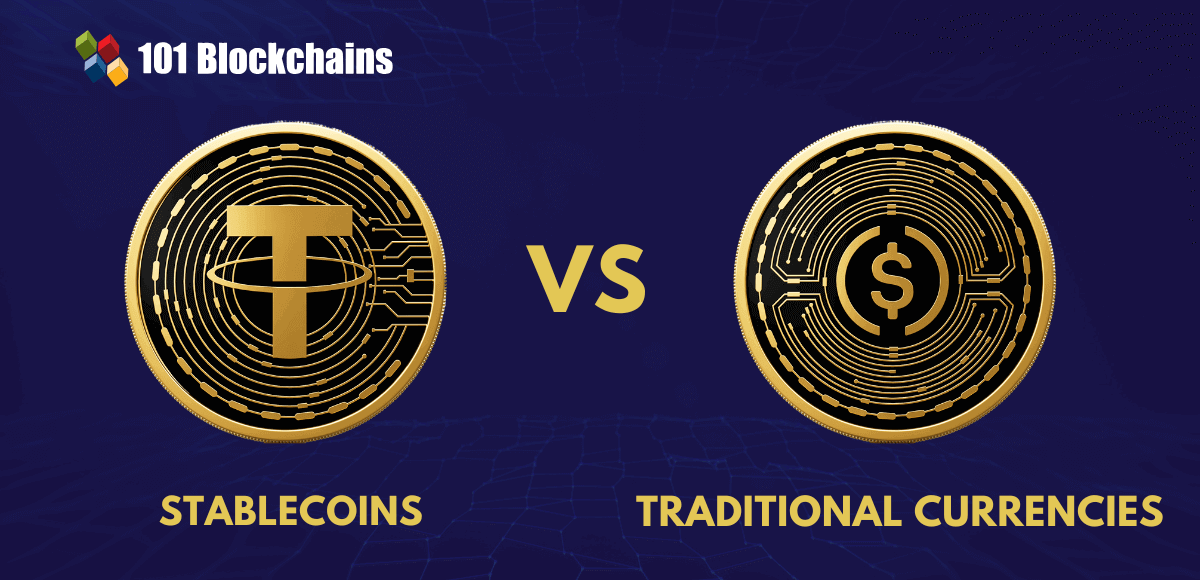Learn how blockchain truly works, master key definitions, and uncover what makes smart contracts so "smart." Dive into the fundamentals, gain valuable insights, and start your blockchain journey today!

- Comparisons
James Howell
- on May 12, 2022
ERC 1155 Vs. ERC 721 – Key Differences
With the growing popularity of NFTs, the ERC 1155 vs ERC 721 debate has also become a critical concern. Let’s dive in to understand the difference between ERC 1155 and ERC 721.
Ethereum evolved as one of the prominent solutions for resolving the limitations associated with Bitcoin, the first-generation blockchain network. The primary idea behind Ethereum revolved around introducing an open-source blockchain network with the functionality for developing smart contracts. One of the most prominent use cases of Ethereum has been evident in token development.
As a result, the ERC 1155 vs ERC 721 debate has become a critical concern for everyone interested in Ethereum. Most important of all, these two token standards are quite significant for the emerging applications of non-fungible tokens. The popularity of ERC 721 and ERC-1155 token standards have been largely revolving around the growth of NFTs. Let us learn more about these two token standards and how they are different from each other.
Curious to understand the fundamentals of ethereum? Join Yearly/Yearly+ Plan and get free access to the Ethereum Development Fundamentals Course Now!
What are ERC Token Standards?
Before discussing the ERC 721 vs ERC 1155 differences, it is important to have a brief overview of ERC token standards. What is the significance of ERC token standards in the crypto landscape? ERC or Ethereum Request for Comments is basically a technical document that provides specifications for the methods, innovation, research, and traits for a specific group of users in the Ethereum ecosystem.
The ERC token standards like ERC-721 and ERC 1155 offer explanations for different rules pertaining to ERC tokens on Ethereum. Most important of all, the Ethereum community contributes to amendments in the rules of the token standards after a comprehensive review. As of now, the three most popular ERC token standards include ERC-20, ERC-721, and now, the ERC-1155.
Excited to learn the basic and advanced concepts of ethereum technology? Enroll Now in The Complete Ethereum Technology Course
Why Should You Think of ERC 721 vs ERC 1155?
Ethereum has grown into a massive ecosystem of decentralized applications and web3 trends. As a result, development teams have to come up with new token standards. The earliest instances of token standards, such as the ERC-20 token standard, helped in defining the functionalities of traditional tokens. On the other hand, the ERC-20 token emphasized associating every asset with fungibility, thereby offering the functionality of fiat currency.
On the other hand, ERC 721 has been gaining notorious levels of attention in recent times. Why? The primary reason for the increased adoption of ERC-721 token standards is the growing hype around NFTs. Non-fungible tokens are everywhere in the tech world, starting from social media to crypto research papers. The ERC-721 token standard offers the right foundation for creating a customized, non-interchangeable token. For example, you can create a unique collectible trading card with the ERC-721 token or a completely unique personal avatar.
Where does ERC 1155 come into the picture? The comparisons between ERC-721 and ERC-1155 are gradually becoming more significant for the future of crypto. You must notice how ERC-721 focuses only on non-fungible tokens. This is where the difference between ERC 1155 and ERC 721 becomes quite clearly evident.
The ERC-1155 token standard comes with a revised set of traits, which allows the mixed use of fungible and non-fungible tokens. Quite confusing, isn’t it? NFTs are gradually evolving as a major force in popular culture. Therefore, the token standards for creating and managing NFTs are obviously crucial aspects of their future. Developers can explore a wide range of options in the unique traits of the token standards for creating applications tailored to their needs.
Get familiar with the terms related to ethereum with Ethereum Flashcards
ERC-721 Token Standard
The first entry in an ERC 1155 vs ERC 721 comparison points at the latter. If you look closely, the ERC-721 token standard actually started off the NFT phenomenon. The standard was a first of its own kind and helped in creating unique tokens. While non-fungible tokens had been there for a long time, ERC 721 opened up the gates for the mainstream popularity of NFTs. ERC-721 standard played a vital role in introducing the unique NFTs to the public with CryptoKitties.
The developers of CryptoKitties, Dapper Labs, brought ERC-721 in 2017 with an Ethereum Improvement Proposal or EIP. The CryptoKitties is a set of unique, randomly generated kittens you can use as digital collectibles. You must note that the CryptoKitties are completely unique, and no one can replicate them. In addition, the transaction history offers a clear impression of the kitty’s ownership records since its creation.
Many of you must have grabbed some points for ERC 721 vs ERC 1155 comparison from these highlights of ERC-721. However, it is also important to note that ERC-721 tokens are not all about complete uniqueness. As a matter of fact, the ERC 721 token standard offers the following additional feature specifications.
- Flexibility for transferring NFTs between accounts alongside the facility of trading NFTs for other currencies.
- Easy options for finding out the owners of a particular asset.
- Effective identification of total supply for a specific set of NFTs on the network.
ERC-721 token standard has actually served as a formidable force in driving the popularity of NFTs by huge margins. Interestingly, many NFTs based on the ERC-721 token standard have dominated the crypto landscape. Some of the notable examples of projects based on the ERC-721 token standard include NFT artwork or avatars, PFP projects, and fractional ownership in virtual land parcels.
Start learning Ethereum with World’s first Ethereum Skill Path with quality resources tailored by industry experts Now!
ERC-1155 Token Standard
The second player in the ERC 721 vs ERC 1155 token standard debate offers a practical solution to the different setbacks evident with ERC-721. The origins of the project go back to the Enjin Project, which introduced the token standard in 2019. One of the most striking highlights of the ERC 1155 token standard is the fact that it includes the best of ERC-20 as well as the ERC-721 token standard.
Enjin project focused on challenges associated with the ERC-721, especially the lack of flexibility for batch transfers. In the case of ERC-721 token standards, you would need individual transactions for each NFT while transferring multiple NFTs. As a result, the transactions can end up imposing high costs for trading each NFT individually.
The most notable aspect is the difference between ERC 1155 and ERC 721 focuses largely on support for batch transfers. ERC-1155 allows encompassing multiple assets in one smart contract, thereby enabling their transfer with limited network congestion and lower transaction costs. The next significant highlight of the ERC 1155 token standard is the support for non-fungible as well as fungible tokens. How? ERC-1155 offers the ability to support multiple states on a single contract and address.
On top of it, ERC-1155 also stands higher in the ERC 1155 vs ERC 721 debate for the ability to create semi-fungible tokens. The semi-fungible tokens would basically serve as fungible tokens during trading, and they would become NFTs upon being redeemed. Another notable aspect pertaining to the ERC-1155 token standard is the facility for reverting token transfers.
Become a member now to watch our on-demand webinar on Demystifying Non-Fungible Tokens (NFTs).
Comparison between ERC 721 and ERC 1155

Please include attribution to 101blockchains.com with this graphic. <a href='https://101blockchains.com/blockchain-infographics/'> <img src='https://101blockchains.com/wp-content/uploads/2022/05/ERC-1155-Vs-ERC-721-–-Key-Differences.png' alt='ERC 1155 Vs ERC 721='0' /> </a>
The two popular ERC token standards in the crypto space right now have unique traits. However, the functionalities of the ERC-1155 standard showcase how it can overshadow the ERC 721 token standard. On the other hand, it is important to identify the situations where ERC-721 serves as a better fit than ERC-1155. Here is an outline of the differences between ERC-721 and ERC-1155.
-
Ease of Use
The first factor in a comparison of ERC 721 vs ERC 1155 refers to the ease of use. In the case of ERC-721, you would need a single operation for each transaction. On the other hand, ERC-1155 enables the facility for multiple operations within a single transaction. The best thing about ERC 1155 is that the smart contracts could offer support for an unlimited assortment of tokens. On the contrary, the ERC-721 token standard implies the need for new smart contracts for transactions with each type of token.
-
Batch Transfers
The second pointer in the difference between ERC 1155 and ERC 721 draws the limelight on flexibility for batch transfers. You can use the ERC-1155 token standard as vital support for facilitating batch transfers of tokens. The facility of batch transfers plays a crucial role in reducing the transaction costs and time associated with each transaction.
On the other hand, ERC 721 token standard implies the need for creating an individual smart contract for transferring each NFT or token. If you plan on sending multiple NFTs in an ERC-721 system, then you have to create transactions for individual NFTs. As a result, the load on the network increases by massive margins, thereby leading to congestion and increased transaction cost and time.
-
Support for Semi-fungible Tokens
Just as the world started experimenting with different uses of non-fungible tokens, everyone is gearing up to welcome semi-fungible tokens. The standard non-fungible and fungible tokens have become quite redundant with their own limitations. Semi-fungible tokens bring the best of both by enabling the conversion of fungible tokens into NFTs or vice versa. Interestingly, ERC 1155 token standard offers the flexibility for creating semi-fungible tokens. Most important of all, the ability to convert digital or real-world assets into NFTs or vice versa is a huge advantage for the ERC-1155 token standard.
-
Security of Assets
Another significant point of difference in the ERC 1155 vs ERC 721 comparison points at the features of security. Many crypto users have one common nightmare, i.e., sending their assets to the wrong address. The immutable nature of transactions on the blockchain is obviously one of the defining traits ensuring the safety of assets on the blockchain. However, the feature can be quite costly for an honest mistake.
With the ERC-721 standard, you don’t have the facility for reclaiming your assets if you transferred them to the wrong address. On the contrary, the ERC-1155 token standard offers a unique feature known as the ‘safe transfer’ function. The safe transfer function is a product requirement for evaluating a transaction’s validity and also enables hassle-free token transfers.
Want to learn blockchain technology in detail? Enroll Now in Certified Enterprise Blockchain Professional (CEBP) Course.
Bottom Line
The most crucial highlight of the difference between ERC 1155 and ERC 721 focuses on the way ERC-1155 addresses the limitations of ERC-721. While ERC-721 offered the foundation for non-fungible tokens, ERC-1155 offers the traits required for future NFTs. Once you begin exploring the definitions of both token standards, you can uncover many critical points of differences.
However, ERC-1155 presents an upper hand when it comes to long-term prospects for NFTs. The new token standard, introduced in 2019, has been phenomenal in introducing possibilities of semi-fungible tokens and batch transfers of NFTs. As a matter of fact, the ERC-1155 token standard can improve the usability of NFTs and remove the barriers to NFTs. Learn more about the token standards and their implications on the broader crypto landscape.
*Disclaimer: The article should not be taken as, and is not intended to provide any investment advice. Claims made in this article do not constitute investment advice and should not be taken as such. 101 Blockchains shall not be responsible for any loss sustained by any person who relies on this article. Do your own research!





